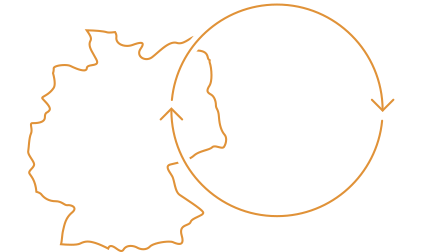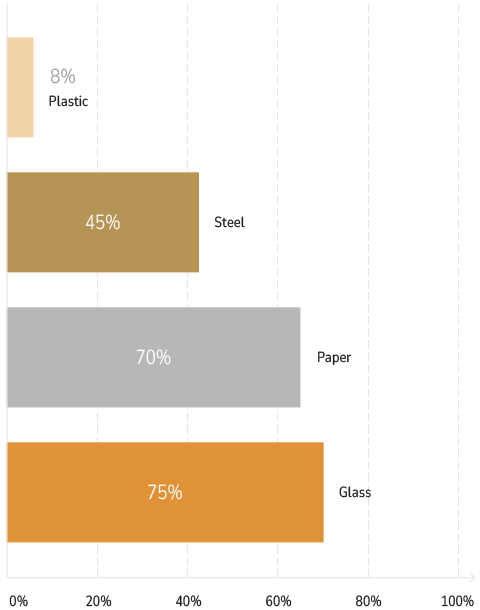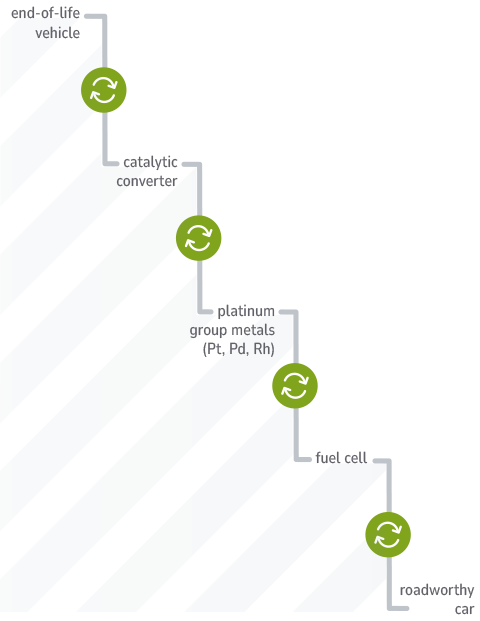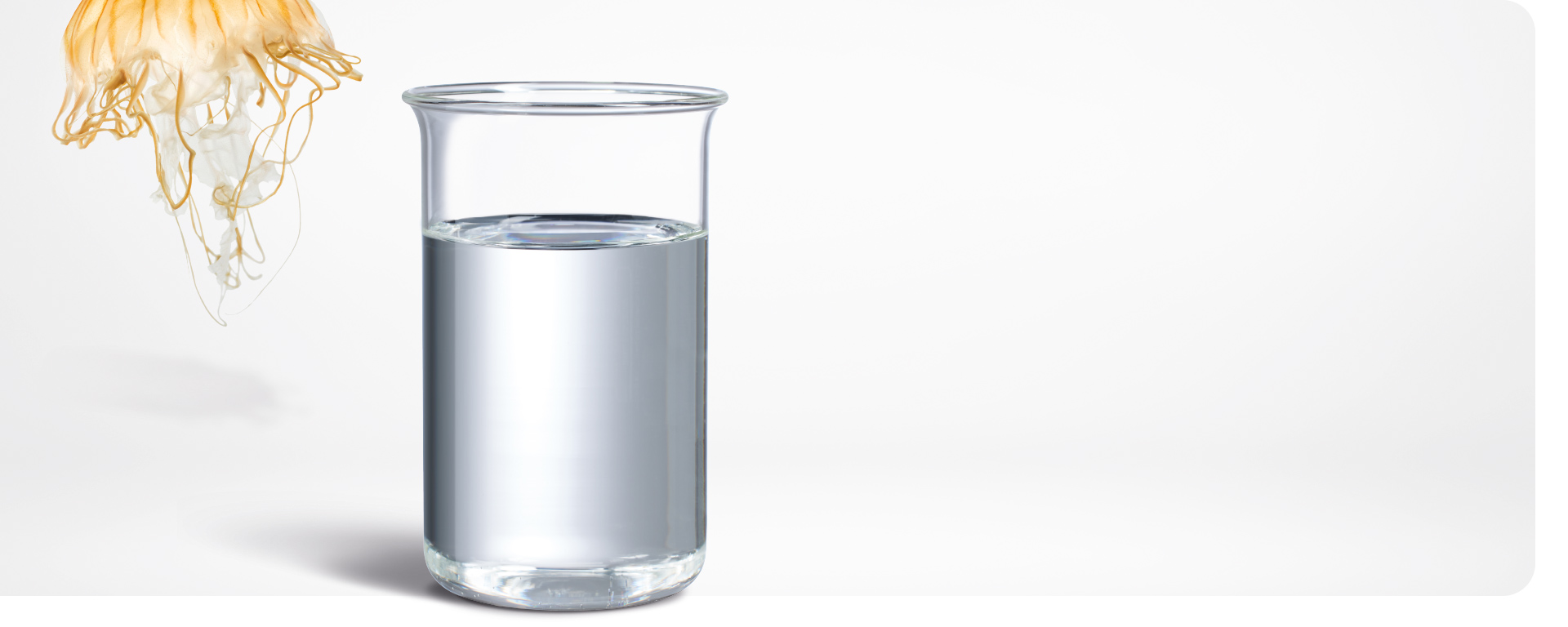Find out more about how recycling curbs climate change
Search
REMONDIS’ business locations around the world
Being one of the world’s leading recycling, service and water companies, REMONDIS has around 1,000 business locations across the globe. These can be found in over 30 countries in Europe, Africa, Asia and Australia.
REMONDIS’ business locations in Germany
REMONDIS’ business activities in Germany are managed and carried out by its six regional companies. REMONDIS also has a whole variety of specialist companies, many of which are based here in Germany as well.
The success story of recycled raw materials began back in the late 1990s when there was a rapid increase in commodity prices. This development meant that using recycled raw materials as a substitute became an ever more attractive option.


Recycled raw materials - a look back and a look ahead
Here in Germany, people realised just how important it was to become less dependent on the countries exporting the raw materials. There is only one real solution for countries with so few raw materials of their own such as Germany: namely to process the raw materials already circulating on the market so that they can be reused again and again. The only way to achieve this is to systematically recover recyclables from industrial and household waste – i.e. not to see waste as a material to be disposed of but as a source of raw materials. And, ideally, this should be the case for all categories of refuse, from old packaging all the way through to waste electrical and electronic equipment.
Germany and Europe with a new strategy for raw materials
The European and German recycling policy came into being in response to the changing situation on the global market, something that also saw China playing a major role. The People’s Republic – which had previously supplied 97% of Germany’s rare earth imports – altered its export policy in 2011 making it far more restrictive. In 2018, the country then refused to import substandard plastic waste. Since then, Germany and the EU have been forced to find their own recycling solutions. To achieve this, policymakers passed a new Packaging Law that prescribes a gradual increase in recycling rates until 2022. For plastics as well as for all other waste fractions such as glass, paper, metals and composite materials. Moreover, drinks cartons were treated as a separate category for the first time.
Politics & recycling – the provisions set out in the new Packaging Law
| Material | Rate since 2019 | Rate from 2022 |
|---|---|---|
| Glass | 80 % | 90 % |
| Paper/cardboard | 85 % | 90 % |
| Ferrous metal | 80 % | 90 % |
| Aluminium | 80 % | 90 % |
| Plastics | 90 % (of which 65% mechanical) | 90 % (of which 70% mechanical) |
| Drinks cartons | 75 % | 80 % |
| Other composites | 55 % | 70 % |
Further details about the different fractions and recycled raw materials can be found in the section material streams & climate change mitigation
From the Paris Climate Agreement to the Green Deal – things are moving along
Even if the acceptance of recycled raw materials among industrial businesses is in need of improvement, things are definitely moving in the right direction. One of the reasons for this can certainly be put down to politicians tightening the screws on companies. The EU would also seem to be taking things seriously, especially since it passed its Green Deal, and is intending to systematically drive forward sustainable production processes. Even the Paris Climate Agreement – which is dismissed by many as industrial nations merely paying lip service – is having an impact. Even if, for the most part, this is only on reducing emissions. The Paris Effect study, which was published in 2020, concludes that zero-carbon solutions are becoming increasingly more competitive than climate-damaging solutions. The next move is to tap into the potential of recycled raw materials. Here are two examples of the actions currently being taken in Germany and the EU.


Germany’s 5-point plan for less plastic and more recycling
In response to the ban imposed on certain single-use plastic products by the EU Parliament on 27 March 2019, the German Ministry of the Environment drew up a 5-point plan that contains measures to reduce volumes of plastic and to grow recycling. This plan also includes an initiative to increase the quality and acceptance of products made from recycled plastic. For example, by reducing licence fees for packaging produced using recycled raw materials.

The EU’s Plastics Strategy to promote recyclates
Diverse measures should be implemented across the European market in order to significantly increase both plastics recycling and the demand for recycled plastic over the next five to ten years. This should include introducing quality standards as well as driving investment in recycling technologies.
The latest assessment of the opportunities and limits of recycling in the context of the circular economy can be found in the paper (with the same name) published by the Resource Commission at the German Environment Agency (KRU) that was written in 2023 with REMONDIS’ support. Download the paper as a PDF here
The link between supply and demand
Recovering and processing recyclables so that they can be returned to the market as recycled raw materials is one thing. No matter how good a recycling network may be, however, it is of little use if there are not enough customers actually willing to purchase the recycled raw materials. Many industrial sectors are beginning to rethink the way they do business and are moving towards being more sustainable. Both this change in attitude and the above-mentioned political measures are promoting the use of recyclates. However, there is still room for improvement, especially in the plastics processing industry. The battle faced here continues to be between long-term environmental efforts and short-term economic goals. If the price for crude oil is low, for example, then it is cheaper for industry to use plastic made from virgin materials rather than from recyclate.


The share of recycled raw materials used to make new products (Germany, 2018)
All in all, recycled raw materials are growing in importance in Germany. Their share of all the raw materials used in the country (not including mineral oil, uranium, coal and gas) increased more than fivefold between 1995 and 2011.

Recycled raw materials as a driver of innovations
If the subject of recycled raw materials is systematically thought through to the end, then there are some real opportunities for industry to grow their levels of efficiency. This is especially true if companies succeed in implementing cascade use, i.e. raw materials are reused several times and integrated into a variety of production processes. A raw material may be of a lower quality when it is recovered from a product at the end of its service life but this most certainly does not mean that it is no longer of use. It may make sense for manufacturers to extend their portfolio so that this raw material can be used in a different production line. Alternatively, this raw material can be processed and reused by an external firm.
An example: cascade use within the automobile industry


Platinum group metals are recovered from old catalytic converters and then used to produce fuel cells
Further advantages for industry
Bespoke formulas
Recycled raw materials – especially plastic pellets – can be produced to meet the exact requirements of individual industrial customers.
Guaranteed supplies
Recycled raw materials mean industry is no longer dependent on the volatility and uncertainties of the commodity markets.
Societal acceptance
Society is becoming more and more environmentally aware. Sooner or later, the only marketable products will be those that are sustainable and made of recycled raw materials.
Greater financial help
Policymakers are planning to financially support companies that use recycled raw materials. For example by offering grants or lowering licence fees for packaging.

More science is needed for more recycled raw materials
There is a whole host of material life cycles that still need to be closed so that the most can be made of their recycling potential. Simply keeping up with the challenge of having to deal with ever more complex products with their ever more difficult to separate parts is a mammoth task in itself. Besides developing brand new technologies, the existing processes also need to be optimised. For example, to improve the quality of the recycled raw materials or to recover the recyclables more efficiently so that the systems are more profitable.
Examples of future fields of work
Recycling wind turbines
Wind turbines are an important component of the energy transition. However, they also pose environmental problems. Their rotor blades are made of glass fibre reinforced plastic (GRP) that, put quite simply, cannot be recycled at the moment. Which means they end up in waste incineration plants. This is not promoting the goal of ‘recycling for reuse’ and will also generate new problems in the future. The rotor blades used by more modern wind turbines contain carbon fibres that can cause the plant to short-circuit when they are incinerated. Either way, there is a great need for innovations when it comes to a wind turbine’s rotor blades. Both in the area of recycling as well as in product development. The whole process would be far less complicated if the blades were designed from the start so that their individual components could be easily separated from each other at a later date. The subject of recycling wind turbines is, therefore, also an excellent example of just how important it is for scientists, companies and recyclers to work together.
Glass fibre reinforced plastic is a very inexpensive option for manufacturers. Which is one of the reasons why recycling efforts have so far had a raw deal.

A wind turbine’s rotor blades are unable to be recycled with today’s technology. And the same is true for recreational boats as they, too, are mostly made of CFRP

It is easy to recycle the front glass and aluminium frames of solar panels. Getting the metals out of the inside is altogether more difficult
Recycling solar cells
With the photovoltaic boom starting around 20 years ago, a growing number of solar cells are now reaching the end of their service life. Industry experts are forecasting that there will be 100,000 tonnes of solar scrap in 2025. And 400,000 tonnes in 2030. This is inevitably leading to the increasingly urgent question of how to recycle them. Solar cells – the centrepiece of solar panels – not only contain several hundred grams of silicon but also other valuable raw materials such as lead, zinc, tin and silver. These materials, however, are embedded in thin plastic film and blended together in such a way that it is impossible at the moment to separate them from each other. Scientists are already working on possible solutions. Nothing that they have come up with to date though is really marketable. Recycling solar cells is most definitely a subject that researchers will have to focus on in the future.
Recycling lithium-ion batteries
One particularly urgent subject is how to recycle batteries from electric cars – the so-called lithium-ion batteries. Sooner or later, these will not only be handed over in large volumes for recycling. Every effort must also be made to recover their valuable contents that include materials such as nickel, cobalt, copper and lithium. Why? Because these materials are rare, expensive and the mining of their primary counterparts has, in some cases, a devastating impact on the environment. There is currently no recycling system on the market that is able to efficiently recover all these valuable materials on an industrial scale. And yet there is a good chance that progress will be made over the coming years. After all, one of the sectors most affected by this is the automobile industry, which is well-known for its innovative spirit. It will also be in its own interest to find a way to recycle lithium-ion batteries so they can be used in in-house material life cycles.

One of the consequences of the growth in e-mobility will be that the recycling sector will eventually have to deal with hundreds of thousands of discarded lithium-ion batteries
Is there a downside to recycled raw materials? Their collateral effect on the Third World
Using more recycled raw materials and fewer primary resources may be the right route to take. We must not forget, however, that this development will have a negative side effect. Even if natural raw materials are mined under precarious conditions in many developing countries, this work is essential for the people living in these areas. A lack of education often means that they have no other way to earn a living. If global consumption of primary raw materials declines and fewer resources need to be extracted from the ground, then this will have an impact on the poorest of the poor. It must be the task of international – and above all European – policymakers to counteract this impact by, for example, initiating educational programmes. A good school education is the only chance for the local residents to improve their qualifications so they can take on better jobs and not be forced to carry out low-paid work for the whole of their lives.

Natural resources are often extracted from the ground by hand in many African and Latin American countries – under dreadful conditions and for a pittance



